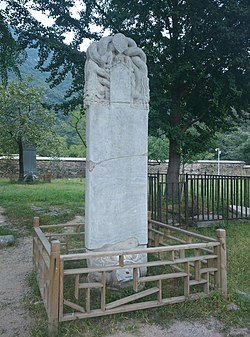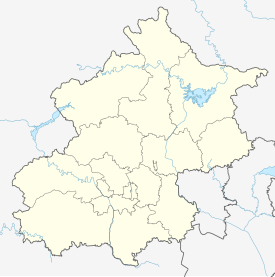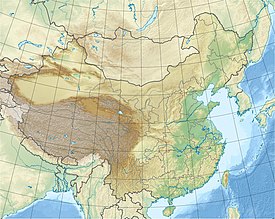| Cross Temple | |
|---|---|
| Native name Chinese: 十字寺 | |
 A Yuan-era stele in the ruins of the Cross Temple. Another stele (left) and some scattered groundwork (right) are visible in the background. | |
| Type | Abandoned Buddhist and Nestorian Christian religious site |
| Location | North Sanpen Mountain, Chechang Village, Zhoukoudian, Fangshan District, Beijing |
| Coordinates | 39°44′35″N 115°54′06″E / 39.74306°N 115.90167°E |
| Built | As a Buddhist temple, possibly 317 |
| Rebuilt | 639, c. 960, 1365, 1535 |
| Cross Temple, Fangshan | |||||||||||||||||
|---|---|---|---|---|---|---|---|---|---|---|---|---|---|---|---|---|---|
| Chinese | 十字寺 | ||||||||||||||||
| |||||||||||||||||
The Cross Temple (Chinese: 十字寺; pinyin: Shízì sì)[a] is a former place of worship in Fangshan, Beijing. The temple was used during different periods by Buddhists and early Chinese Christians. Though it was originally built as a Buddhist temple, some scholars hypothesise that it saw Christian use during the Tang dynasty (618–907). The temple was used by Buddhists during the Liao dynasty (916–1125) and by Christians during the Yuan dynasty (1271–1368). It returned to Buddhist use during the Ming dynasty (1368–1644), before being sold in 1911. It was first recorded in modern scholarship in 1919, damaged during the Cultural Revolution, and re-established as a national-level protected site in 2006. Some scholars consider it to be the only place of worship of the Church of the East (also known as Nestorian Christianity) discovered in China.[b]
Today, the site features two ancient steles, as well as groundwork and the bases of several pillars. The steles date to the Liao and Yuan dynasties, but their inscriptions were tampered with during the Ming. During the early 20th century, two stone blocks carved with crosses and other patterns were also discovered at the site, with one of them also bearing an inscription in Syriac. The blocks are presently on display at the Nanjing Museum.
- ^ Borbone 2006, p. 7.
- ^ Marsone 2013, p. 205.
- ^ Drake 1962, p. 23.
- ^ Nicolini-Zani 2011, p. 356.
- ^ Hofrichter 2006, pp. 12–14.
- ^ Mooken 2018, p. 71.
Cite error: There are <ref group=lower-alpha> tags or {{efn}} templates on this page, but the references will not show without a {{reflist|group=lower-alpha}} template or {{notelist}} template (see the help page).

